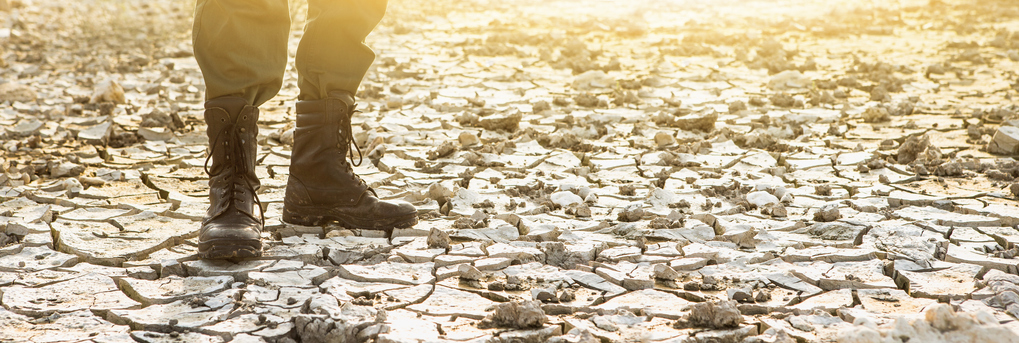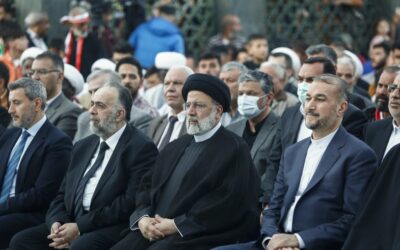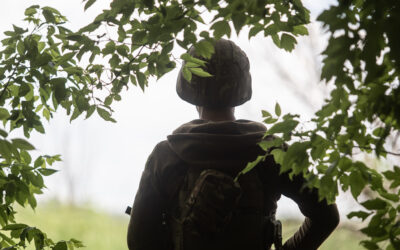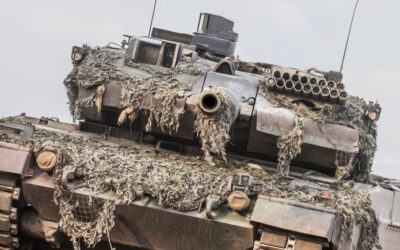
Exclusive Interview: Tracking the U.S. National Intelligence Strategy
SUBSCRIBER+ EXCLUSIVE INTERVIEW – The Office of the Director of National Intelligence (ODNI) is offering some rather overt clues about just how the country’s 18 […] More

The Pentagon often wargames future scenarios for when ‘all hell breaks loose’ with the idea of training for the worst-case scenario. Secretary of Defense Lloyd Austin made clear when he took the helm at the Pentagon earlier this year, that – consistent with President Joe Biden’s focus on climate change – the DOD would include climate as a threat to national security in the next iteration of the National Security Strategy. He also said that the impacts of climate change will be included in wargaming future military exercises.
As part of The Cipher Brief’s Climate Series, Co-Editor Kristin Wood talked with the author of All Hell Breaking Loose: The Pentagon’s Perspective on Climate Change, to get a sense of where the US military may be headed when it comes to dealing with the current and future impacts of climate change.
Kristin Wood, Co-Editor, Cipher Brief Climate Change Series

Kristin Wood is co-Editor of The Cipher Brief’s Climate Series and is a non-resident fellow at the Intelligence Project at Harvard University’s Belfer Center for Science and International Affairs. She is a 20-year CIA veteran and is a Cipher Brief Expert.
Michael T. Klare, Author, All Hell Breaking Loose: The Pentagon’s Perspective on Climate Change

Michael T. Klare is a professor emeritus of peace and world security studies at Hampshire College and a senior visiting fellow at the Arms Control Association in Washington, D.C. He is the defense correspondent of The Nation and the author of fifteen books, including Resource Wars, The Race for What’s Left, and, most recently, All Hell Breaking Loose: The Pentagon’s Perspective on Climate Change.
THE INTERVIEW
Wood: In 2019, you published All Hell Breaking Loose. Why did you feel like 2019 was the time to write such a book?
Klare: The book was a result of two concerns coming together. All of the books I have written deal with resources and conflict. In writing my previous book, The Race for What’s Left: The Global Scramble for the World’s Last Resources, I became increasingly aware of how climate change is affecting the scramble for resources like food, water, land, and other critical resources. In the course of my research, I discovered that the Department of Defense was studying the same issue and for the same reason- they discovered that resource competition as a source of conflict was being accelerated by climate change.
I became interested in what the Department of Defense was doing because my research interests were lining up with theirs, but at the same time, I had a political interest in this. During the Trump administration, progress on climate change came to a halt. I was deeply concerned about climate change and felt that it was important to find a new way to get at the problem. It was clear at the time that the political discourse in Washington on climate change was frozen. Environmentalists and scientists were saying that it was an immense problem that we had to address while denialists were saying this wasn’t something to worry about; nothing was happening.
It occurred to me that the U.S. military had a position on climate change that was not being heard and this voice might appeal to people who were in neither the environmentalist or denialist camp or people who wouldn’t listen to each other but might listen to admirals and generals who they respect as voices of reason in national security. If they heard that voice, it might help people take climate change more seriously than they had in the past. I thought a book that presented that voice and view would play a valuable political role at a moment when no progress was being made on climate change nationally.
Read The Cipher Brief’s Climate and National Security Interview with Admiral James Stavridis (Ret.)
Wood: Starting at the top strategic level, what is the Pentagon’s perspective on climate change?
Klare: At the top, leadership will flat out tell you that their primary concerns are China and Russia and great power competition. Then, they’ll say there are other threats we need to worry about including terrorism, Iran, and climate change.
When they talk about climate change, they do so in a variety of ways. Climate change is creating more disturbances, unrest, and chaos in many parts of the world. This chaos and unrest is diverting them from what they see as their primary concern: Russia and China. The military getting dragged into conflict and disaster relief in other parts of the world is undermining their ability to address their primary concern by creating new sources of conflict.
They also see climate change as undermining their ability to fight because it is attacking their installations at home and around the world through rising seas, extreme storm damage, interfering with training, and conducting military operations. They see that these impacts are going increase. The further they look into the future, the more they see that their ability to carry out their primary job of fighting Russia and China will be undermined and impeded by climate change. This is why they can’t ignore climate change. They would rather prepare for war with Russia and China, but they see that task will increasingly be made more difficult by climate change.
Wood: How do climate change and extreme weather affect the DOD’s mission and how is that expected to evolve as the globe continues to heat?
Klare: Most of today’s high-ranking officers cut their teeth in the Middle East and North Africa, areas that have seen the impact of climate change much more severely than the rest of the world especially in terms of drought and water scarcity and those events’ impact on social divisions and antagonisms. They saw firsthand the impacts of climate change on the operating environment they were fighting in. This gave them an awareness of climate change impacts and how it could stir up conflict within sectors of society.
Climate change is something these people know firsthand – it isn’t theoretical. They also became very aware during Afghanistan and Iraq how vulnerable the U.S. military has become due to its heavy reliance on fossil fuels. Our military is a very heavily mechanized military, and it isn’t a surprise that our military requires a significant amount of petroleum to carry out its operations. When you have forces operating in remote areas of Afghanistan, it proved to be exceedingly dangerous to supply them with the needed petroleum. In fact, sending convoys of oil to remote bases proved to be the most dangerous activity in that war; more losses occurred in convoy delivery than in anything else. The military became very aware of the dangers of reliance on fossil fuels and began exploring alternatives to fossil fuels.
The U.S. military is what’s called the forward deployed military- most of our combat forces are not at home. Most of our combat forces are in Germany, Japan, South Korea, and other places around the globe. To support these forces, you have to have a robust infrastructure at home and most of that is located on our coasts.
We depend a great deal on our Navy to support our forces and all of their bases are on the coasts. Those bases are all extremely vulnerable to the effects of climate change and are already beginning to suffer. One of our biggest Naval bases, Norfolk Naval Base in Virginia, is practically at sea level and has been flooded repeatedly at high tides or during hurricanes. That base has been put out of operation for days at a time, and this is the case at other bases up and down the coasts as well. The military is already aware that storm damage and sea level rise are going to pose an enormous threat to the ability to support forward operations given this climate threat.
The Cipher Brief hosts private briefings with the world’s most experienced national and global security experts. Become a member today.
Wood: The U.S. military frequently gets pulled into rescue operations or disaster recovery operations in the United States or internationally. Can you tell us a bit about how they’ve seen the scope of that mission increase or stay the same?
Klare: That is something that the U.S. military does regularly, and they pride themselves on their ability to provide humanitarian aid and disaster relief when disasters occur. However, they are also very aware that the number of these disasters is likely to increase. In 2017, when hurricanes Irma, Maria, and Harvey hit all in a row, the DOD found they began running out of forces to deal with all of the emergency assistance programs. After Harvey, they sent a huge flotilla of ships to Houston. When Irma hit, they moved the ships to Florida. When Maria hit Puerto Rico, they had to scramble to find other forces to provide assistance. The damage from Maria was so extreme that the Army Corps of Engineers was there for nearly a year restoring power and operating the country.
This was something the military was glad to do but they realize this is going to become more and more frequent and demanding. This will begin to cut into their ability to carry out what they see as their primary mission to defend the country against foreign enemies.
Wood: What are your concerns related to the warming Arctic Circle and what have you seen the Pentagon express concern about?
Klare: From a climate change perspective, everyone should be concerned about the Arctic because it is warming so rapidly – about twice the pace of the rest of the planet – and is affecting weather patterns around the world, especially in the Northern Hemisphere. It also is melting the ice cap – the polar ice sheet that covers the Arctic in the winter. Each year, the coverage of the ice cap is shrinking. That is the single most noticeable impact of climate change in our time that can be recorded year after year.
The shrinking of the polar ice cap has many impacts. It allows for oil and natural gas drilling in places that were previously inaccessible. This presents the danger of oil spills which would be much more dangerous and destructive in the Arctic because the wildlife there is already at the brink of survival. The Coast Guard and other agencies also have to think about how to deal with an oil disaster in the Arctic. On top of that, the Arctic has become a military issue because previously, the Navy never had to worry about patrolling the Arctic because no ships could sail there. Now, it’s becoming a source of competition between major powers because maritime borders have not been fully resolved. Russia, the United States, Canada, Norway, and Denmark all claim control of areas of the Arctic.
Russia has vastly increased its military presence in the Arctic region. This has become an issue for NATO and, in turn, the United States, leading both to expand their military capabilities in the region.
There is a cold war military competition developing in the Arctic region. China, which is not often thought of as an Arctic power, claims to be a near-Arctic power and believes that in time they will be able to cheaply and quickly ship good from China to Europe via the Arctic. They sent icebreakers to the Arctic and developed links with Greenland and Iceland which has made the U.S. nervous. As a result of climate change, the area has become an arena of geopolitical competition.
Wood: Russia has close to 40 icebreakers, including a fair number of nuclear-powered icebreakers which are much more reliable in that kind of environment. The U.S. has one or two depending on if you count the one being repaired in a dry dock. It costs a billion dollars and 10 years to construct an icebreaker. What have the Pentagon leaders you’ve spoken with said about how to mitigate the Russian advantage while building up and developing the U.S. fleet?
Klare: The Arctic is melting which means the need for icebreakers is diminishing as there is less ice to break. The area of greatest concern to the U.S. Navy is the Bering Sea, the area between Norway and Northwestern Russia, because that is where the Russian Naval bases are. That is how they get their nuclear submarines into the Atlantic Ocean, which is our greatest worry, and that area is ice-free. The U.S. has reestablished its Atlantic fleet and begun training operations above the Arctic Circle in the Bering Sea in the areas adjacent to Russian territory. We’ve deployed B-1 bombers there, we have a permanent military presence in Norway, and we conduct regular military exercises in the area of the far North of Norway. We don’t need icebreakers to fight a war with Russia if it comes to that in the area of greatest strategic concern.
Wood: You have a chapter in your book called “Going Green: The Pentagon as a Change Agent.” What are some of the ways the Pentagon is already or could be a change agent and what are some of the experiments they’ve conducted with different approaches towards going green?
Klare: The military came to this in part, because of their recognition that dependence on fossil fuels was a strategic liability. There was a lot of concern about that in the previous decade and a lot of experiments were done to reduce reliance on fossil fuels and become more energy independent. One of the leaders in this was Ray Mabus, the Secretary of the Navy in the Obama administration, who conceived the idea of the ‘Great Green Fleet’.
Mabus had the idea of creating a fleet that was entirely powered by alternative fuels. He wasn’t able to completely achieve his goal, but he did create a ‘Great Green Fleet’ of nuclear-powered aircraft carriers and destroyers powered by a mixture of conventional fuel and animal fats and sent it into the Pacific. At every step along the way, this fleet demonstrated energy saving techniques that the Navy could follow. Mabus also pushed the Navy to make its bases energy self-sufficient to the greatest degree possible and built giant solar farms, making the Navy a leader in developing solar-powered sources for its bases’ energy requirements.
The Army took this as a challenge to be able to go anywhere and be zero dependent on local resources. They’ve experimented a great deal with a lot of climate adaptation technologies.
During the Trump administration, these activities went underground. They didn’t stop, but you couldn’t talk about them as climate change related activities, but they continued under other euphemisms. The military has experimented and implemented a wide variety of efforts to enhance the self-sufficiency of its bases, and I think a lot of this technology is applicable to civilian society.
Wood: Over the last few years, the Pentagon has released a number of reports on the vulnerability of its bases and facilities around the world. Some of the reports have been quite stark in terms of the costs to mitigate the risks of climate change to their facilities. What are Pentagon leaders saying privately about the risks of facilities and mission due to climate change?
Klare: I’ll begin with the Navy. Naval bases, by definition, are at the coast and some of their most important bases are at extreme risk because of climate change and have already suffered a great deal of flooding. They’ve had to invest a lot of money in seawalls, raising the height of buildings and docks, and bringing buildings up to code that coastal bases require.
All of this is being quietly written into the installations manuals that base commanders use. It’s adding expenses, but as we saw between Hurricane Michael in 2017, and the flooding of Offutt Air Base in Nebraska in 2018, climate change has already become a costly item to the defense budget and Pentagon officials are well aware of that and that the cost will rise in the years ahead.
The biggest question is how long the military can hold on to some of these coastal bases before they have to be relocated at the cost of billions or trillions of dollars. Nobody wants to talk about that, but there is a complete understanding that the day for that will come. Dealing with climate change is going to be a trillion-dollar cost for the military in the years ahead.
Wood: With the new administration and Commander in Chief who has made climate change and addressing it a central tenant of their goals as an administration, what do you see changing, evolving, and shifting from the Pentagon’s current response to what they’ll do to handle climate change over the next four years?
Klare: First, there will be a change in attitude. The Secretary of Defense Lloyd Austin has said that climate change should be included as a threat to national security and revise the national defense strategy to reflect that. The current edition of the national defense strategy that was written in 2018 by Secretary James Mattis has zero mention of climate change. It was completely about great power competition with Russia and China. That made it hard for military officers who might be concerned about climate change and its impacts to raise that concern and develop programs to address the problem. Austin has made very clear that climate change will be included in the next iteration of the National Security Strategy as a threat to national security.
This will mean that from the top down there can be discussion about developing programs and that will make it much easier for base commanders to say they need money to address the vulnerabilities of their facilities because of climate change. Something else we will likely see is cooperation with the military forces of other countries to address climate change. This is something the Pentagon discussed as early as 2010 during the quadrennial defense review of 2010. They said that because climate change is accelerant of conflict which in turn creates more tasks for the U.S. military, we should cooperate with the militaries of friendly countries to enhance their resilience of their countries to climate change
That idea became part of the foreign policy of the Department of Defense and I think you’ll see that become a much more highlighted part of foreign policy. We talk about China as our number one threat in the Pacific. We need to work closely with allies like the Philippines, Japan, and other islands in the Pacific that are at extreme risk from rising seas and extreme storms. I think we will see much more effort on the part of the Department of Defense to work with their counterparts in other countries to address the vulnerabilities those countries have and how to make them more resilient in the face of those climate change threats.
Wood: Are there any other key points you want to leave us with relating to climate and the Pentagon?
Klare: I titled my book, All Hell Breaking Loose, because it’s the worst-case scenario and militaries always think in terms of worst-case scenarios. All hell breaking loose would be a scenario where there are multiple climate disasters occurring simultaneously. In 2017, when hurricanes Irma and Harvey hit the U.S., there were multiple fires in California and other Western states. The Pentagon was sending the National Guard in both directions and overseas to address conflict around the world. There comes a point where the military fears it will not be able to carry out its primary duties- they worry about that day coming. They worry that, for example, climate change will pose a threat to nuclear weapons states like Pakistan or India and that climate change could provoke a nuclear war or provoke the breakdown of Pakistan due to ethnic tension arising out of water and food scarcity.
These countries have as many weapons as China and we’re on the path of nuclear weapons falling into the hands of Islamic militants. The U.S. would have to intervene in that case. Imagine that happens while multiple disasters are happening in the U.S.- that is all hell breaking loose. That is why people in the military think that climate change could evolve over time if not addressed now. If we don’t take steps now to mitigate its effects, it could create a situation which would overtake all threats.
Read also Why the Intelligence Community Needs a Climate Change Task Force exclusively in The Cipher Brief
Read more expert-driven national security insights, perspective and analysis in The Cipher Brief
Disclaimer: The Cipher Brief, like other Amazon Affiliate partners, gets paid a small commission based on purchases made via the links provided in this review
Related Articles

SUBSCRIBER+ EXCLUSIVE INTERVIEW – The Office of the Director of National Intelligence (ODNI) is offering some rather overt clues about just how the country’s 18 […] More

SUBSCRIBER+EXCLUSIVE INTERVIEW – Hostage negotiations are one of the most difficult political issues for a U.S. administration to deal with, particularly in light of a […] More

CIPHER BRIEF REPORTING — On the outskirts of the battle-worn eastern Ukrainian city of Bakhmut, where Russia’s most effective mercenary force once tallied Moscow’s most […] More

Analysis by experts from the Special Competitive Studies Project EXPERT ANALYSIS — In an era of information overload, the rise of AI and machine learning tools, […] More

CIPHER BRIEF REPORTING – Kyiv, Ukraine – Ukrainian President Volodymyr Zelensky recently announced new sanctions against more than 650 individuals and legal entities that the […] More

BOTTOM LINE UP FRONT: A crucial decision by Germany to provide Leopard II main battle tanks to Ukraine and to allow other Leopard-equipped militaries to do […] More
Search